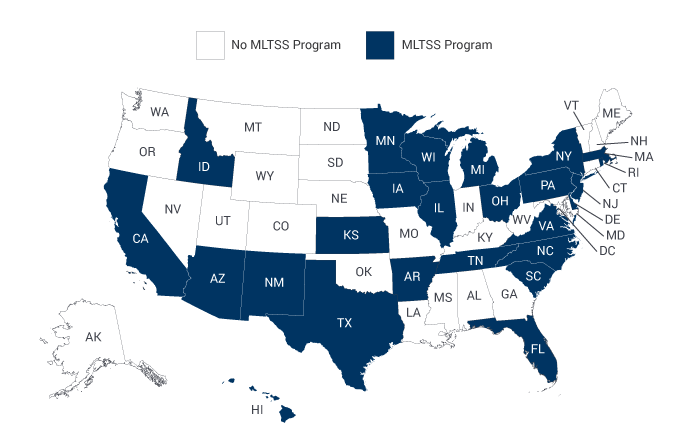State Medicaid programs increasingly use managed care as one of several strategies to improve care coordination and manage costs for populations with complex health care needs and disproportionately high Medicaid expenditures. As of 2021, 24 states operate managed long-term services and supports (MLTSS) programs, in which state Medicaid agencies contract with managed care plans to deliver long-term services and supports (LTSS), up sharply from just 8 states in 2004 (Lewis et al. 2018; ADvancing States 2021). Although much of this growth has been fairly recent, a few states have operated MLTSS programs for many years, and in some cases, several decades.
State Adoption of Managed Long-Term Services and Supports Programs, 2021
Note: MLTSS is managed long-term services and supports.
Source: MACPAC, 2022, analysis of ADvancing States 2021.
The administration of MLTSS is generally similar to Medicaid managed care, but the mix of services and the wide range of needs of beneficiaries who receive LTSS adds complexity, particularly for rate setting and care coordination. Factors involved in setting capitation payment rates for MLTSS include accounting for the range of services, the wide variability in the needs of beneficiaries receiving LTSS, and the need to promote program goals through financial incentives. MLTSS plans typically employ care coordinators who assess beneficiaries’ needs and develop plans of care for the wide range of LTSS for which they qualify.
As MLTSS programs evolve, their scope is expanding. While MLTSS programs typically have targeted people age 65 and older or people with physical disabilities, states are increasingly enrolling individuals with intellectual or developmental disabilities into MLTSS. In addition, many states are working to align MLTSS with Medicare managed care, meaning dually eligible beneficiaries can be enrolled for their Medicare and Medicaid services through the same entity.
States can use their authority under current law to promote the alignment of MLTSS with dual eligible special needs plans (D-SNPs), allowing for higher levels of coordination between Medicaid managed care and Medicare advantage. Fully integrated dual eligible special needs plans (FIDE-SNPs) fully integrate care for dually eligible beneficiaries under a single managed care organization.
Learn more
- Managed long-term services and supports: Status of state adoption and areas of program evolution
- Managed long-term services and supports (MLTSS) overview and themes from site visits
- Medicare Advantage dual eligible special needs plans aligned with Medicaid managed long-term services and supports
- Integrating care for dually eligible beneficiaries: policy issues and options
